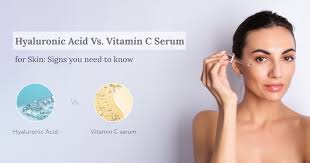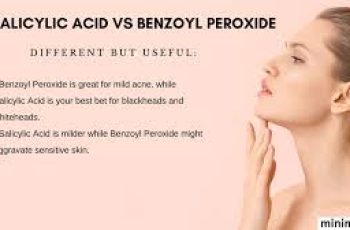
Can I use Vitamin C and Hyaluronic Acid?
Hyaluronic acid is undoubtably one of the most hydrating skincare ingredients out there. This probably explains a little why you’ll find it formulated into a variety of skincare products. Its humectant abilities to draw moisture in and lock it into place resulting in a healthy, comfortable skin. It also ensures the skin barrier remains hydrated throughout the whole day and keeps the skin calm after other potent ingredients are applied.
As for vitamin C you will find sun damage, hyperpigmentation and signs of ageing are targeted leaving the complexion bright and vibrant. When teaming both ingredients you are left with a fully functioning protective barrier ensuring your skin can combat exposure to free radicals. If you are wanting to learn more about how to layer hyaluronic acid and vitamin C you can check out our dedicated blog post.
What goes first vitamin C or hyaluronic acid?
The order in which you apply vitamin C and hyaluronic acid plays an important role in how effective the active level of these potent ingredients absorb and work their way into the skin. There are a few formulations containing both ingredients but if you are using them separately it’s suggested that you apply vitamin C first followed by hyaluronic acid.
With the brightening effects and antioxidant benefits of using a vitamin C serum on the skin, you will provide the complexion with the protection it needs to face the daily exposure to environmental aggressors. Pretty impressive wouldn’t you agree? Following that with hyaluronic acid will result in moisture being locked into the barrier. This is found on the outer surface of the skin and needs to remain in its healthiest state to combat skin damage caused by pollution, exposure to UV rays and other free radical. For all these benefits alone cement the fact that each ingredient works effectively together and, in a way, form a skin reviving power duo.
What should you not mix with hyaluronic acid?
Believe it or not, hyaluronic acid is one of the very few active skin ingredients that can not only be used by all skin types, but also works well with all other formulations and skincare ingredients. Because hyaluronic acid can deliver such impressive hydrating, skin plumping results, there’s no denying that everyone would benefit from having this powerhouse added into your daily skincare routine. However, I would still suggest you consult with a doctor or medical expert to ensure your skin will benefit from adding hyaluronic acid into your routine, whilst avoiding any unwanted reactions. I would also recommend performing a patch test for 24 hours before applying the product all-over the skin.
What can you not mix with vitamin C serum?
Vitamin C serums are known for being highly potent and if used incorrectly or on skin that is too sensitive will result in flushing, redness, and irritation. There are several ingredients that require a certain amount of understanding to ensure you don’t unknowingly cause irritation.
Here are the main active ingredients that is considered best to avoid using together with vitamin C.
Vitamin C + Benzoyl Peroxide
Both ingredients are highly potent with benzoyl peroxide being highly effective, but known for causing some side effects, such as dryness and flaking, especially for those with a dry skin type prone to sensitivity. If you are wanting to use both powerhouses, I suggest applying vitamin C in your morning routine and the benzoyl peroxide in the evening.
Vitamin C + Retinol
With an ingredient as powerful as retinol, ensuring you use it correctly is vital for maintaining your skin health as well as reaping the rewards from this skin changer. Overloading the face with both of vitamin C and retinol will result in severe dryness, itchiness, and tightness to the skin, but that doesn’t mean you should avoid using both in your routine. Just like how I mentioned above it is a case of alternating when you apply them. Because of the brightening effects to the complexion vitamin C can provide, I always feel it’s best to apply it in the morning, so you start the day glowing. Exposure to UV rays results in retinol losing its potency and becoming completely useless so an evening application provides optimal results.
Vitamin C + Niacinamide
Using vitamin C and niacinamide together often develops into a chemical reaction called nicotinic acid which leads to each ingredient competing and therefore becoming somewhat useless. With modern day formulations this reaction is considered a rarity, but it is something to keep in mind when using these ingredients in your daily routine. For the best results and no worry of negative reactions try alternating the days you apply each ingredient.
Vitamin C + AHAs/BHAs
With the potent exfoliating properties of AHAs and BHAs it is often considered too much for the skin to use all three together on the skin. But if used correctly will result in a glowing, healthy complexion. After cleansing use a toner containing either AHA, such as glycolic acid or BHA, like salicylic acid all over the face, leave enough time for the ingredient to make its way into the skin and then follow this with vitamin C. If you see any signs of irritation, flushing or redness avoid using your skincare products like this and instead alternate the days you apply either AHAs/BHAs or vitamin C serum. This will keep the skin luminous, balanced and at its healthiest state.
Do you need moisturiser after hyaluronic acid?
Yes and no, because hyaluronic acid is so hydrating there technically isn’t much need to use moisturiser. However, with the humectant traits of HA drawing moisture into the skin from the area surrounding the face and other products applied to the skin, what you will discover is your moisturiser will help give the skin a hydrated boost that lasts all day.
What order should you use hyaluronic acid?
The consistency of the product containing hyaluronic acid plays an important role. This is because of the basic skin rule I have mentioned in previous blog posts and that is applying products from thinnest to thickest. Hyaluronic acid is usually found in formulas such as serums and moisturisers which tend to be applied during the last stages of your skincare regime. It is important to remembering that the order of application will determine how effective the ingredients and formulas are and how they benefit the skin.
I hope that these have answered a few questions you had about using vitamin C and hyaluronic acid together. If you have any questions, come, and follow us on Instagram and send your questions through to our DMs.


